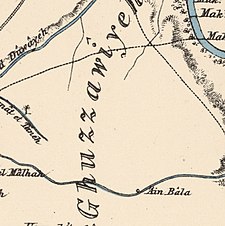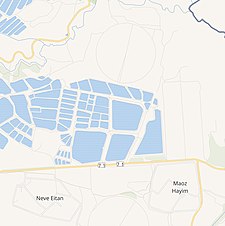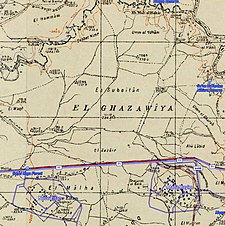Al-Ghazzawiyya (Arabic: الغزاويه), was a Palestinian village located 2 kilometers east of the city of Bet Shean (Bisan). In 1945, the population was 1,640, 1,020 Arab and 620 Jewish.[5]
Ghazzawiyya
الغزاويه al-Ghazawiya, Arab al Ghazawiya tribe[1], Arab Abu Hashiya (Frantzman) | |
|---|---|
A series of historical maps of the area around Al-Ghazzawiyya (click the buttons) | |
Location within Mandatory Palestine | |
| Coordinates: 32°30′08″N 35°32′30″E / 32.50222°N 35.54167°E | |
| Palestine grid | 200/212 |
| Geopolitical entity | Mandatory Palestine |
| Subdistrict | Baysan |
| Date of depopulation | May 20, 1948[1] |
| Area | |
| • Total | 18,408[3] dunams (18.4 km2 or 7.1 sq mi) |
| Population (1945) | |
| • Total | 1,020[2][3] |
| Cause(s) of depopulation | Influence of nearby town's fall |
| Current Localities | Neve Eitan,[4] Maoz Haim[4] |
History
editSeveral archeological sites in the area testify to a long history of human occupancy. The village was surrounded by the archeological sites of Tall-al Barta to the north, Tall al-Husn to the west, and Tall al-Maliha to the southwest. Excavations of Tall al-Husn showed an occupational history extending from the third millennium BC to the eighth century CE, when the site was occupied by an Arab village.[6]
British Mandate era
editIn modern times, the village spread over a wide area of the Baysan valley. The villagers were members of the al-Ghazzawiyya Beduin tribe, who constituted the bulk of the valley's population together with members of the al-Bashatiwa and the al-Suqur.[5] In the 1931 census, conducted by the British Mandate authorities, 'Arab Abu Hashiya had 156 Muslim inhabitants, and a total of 29 houses.[7]
In the 1945 statistics, Al-Ghazzawiyya had 1,020, all Muslim inhabitants[2] with a total of 18,408 dunams of land.[3] Of this, a total of 13 dunams were used for citrus and bananas, 5,185 dunums for cereals, 34 dunums were irrigated or used for orchards,[4][8] while 91 dunams were classified as non-cultivable land.[9]
1948 and aftermath
editIt was occupied by Israel's Golani Brigade on May 20, 1948, during Operation Gideon, an Israeli offensive during the 1948 Arab-Israeli War. The Arab population was forced to flee to nearby Syria or the present-day West Bank.[10]
The Jewish localities of Maoz Haim and Neve Eitan are built on the lands of the former village, though a large percentage of it is used as agricultural land, in particular the wheat crop. According to Walid Khalidi, the village contained an archaeological site, Tell al-Ru'yan which was transformed into waste dump.[10]
See also
editReferences
edit- ^ a b Morris, 2004, p. xvii, village #134. Gives depopulation cause as (?) (C)
- ^ a b Government of Palestine, Department of Statistics, 1945, p. 6
- ^ a b c Government of Palestine, Department of Statistics. Village Statistics, April, 1945. Quoted in Hadawi, 1970, p. 43
- ^ a b c Khalidi, 1992, p. 49
- ^ a b Khalidi, 1992, p. 48
- ^ Khalidi, 1992, pp. 48–49
- ^ Mills, 1932, p. 77
- ^ Government of Palestine, Department of Statistics. Village Statistics, April, 1945. Quoted in Hadawi, 1970, p.84
- ^ Government of Palestine, Department of Statistics. Village Statistics, April, 1945. Quoted in Hadawi, 1970, p. 134
- ^ a b Al-Ghazzawiyya: Town Statistics and Facts
Bibliography
edit- Government of Palestine, Department of Statistics (1945). Village Statistics, April, 1945.
- Hadawi, S. (1970). Village Statistics of 1945: A Classification of Land and Area ownership in Palestine. Palestine Liberation Organization Research Centre. Archived from the original on 2018-12-08. Retrieved 2009-08-06.
- Khalidi, W. (1992). All That Remains:The Palestinian Villages Occupied and Depopulated by Israel in 1948. Washington D.C.: Institute for Palestine Studies. ISBN 0-88728-224-5.
- Mills, E., ed. (1932). Census of Palestine 1931. Population of Villages, Towns and Administrative Areas. Jerusalem: Government of Palestine.
- Morris, B. (2004). The Birth of the Palestinian Refugee Problem Revisited. Cambridge University Press. ISBN 978-0-521-00967-6.
External links
edit- Al-Ghazzawiyya
- al-Ghazzawiyya, Zochrot
- Survey of Western Palestine, map 9: IAA, Wikimedia commons
- Al-Ghazzawiyya, from the Khalil Sakakini Cultural Center




